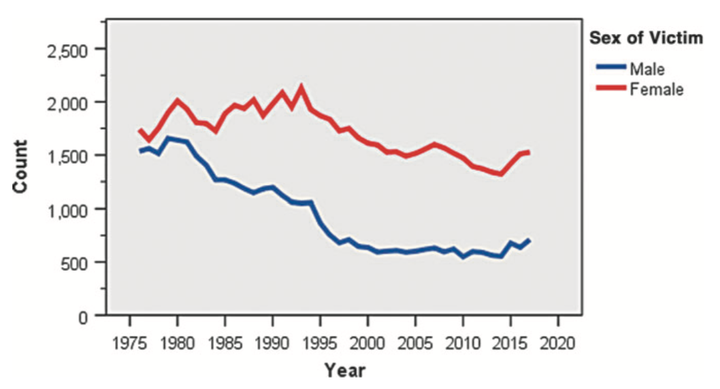
After almost four decades of decline, homicide among romantic partners is now on the rise, according to recent research by Northeastern University criminologist James Alan Fox. The worrisome uptick has been primarily driven by gun violence, he told HuffPost in an interview.
Fox’s paper, which was authored with Ph.D. student Emma Fridel, analyzed gender differences in homicide patterns over a 42-year period, using data obtained from the FBI.
He discovered that intimate partner homicides ― when a person murders their spouse or romantic partner ― increased each year between 2014 and 2017.
In 2014, 1,875 people were killed by an intimate partner, the majority of victims female. In 2015, the death toll rose to 2,096. In 2016, it inched up to 2,149. And in 2017, there were 2,237 such deaths.
Domestic violence groups often repeat the statistic that three women a day are killed by domestic violence. But according to Fox’s most recent data, it is four.
He also found that since 2010, gun-related murders of intimate partners have increased by 26 percent ― a significant rise ― while those involving other weapons like knives have continued to decline. Most of the increase in gun deaths has occurred since 2014, he said.
Fox said he did not want to speculate about the cause of the spike.
“Regardless of the whys, efforts to disarm abusers and stalkers are critical,” he said. “All too often, guns that are purchased and kept in the home, ostensibly for the purpose of self-defense, end up being used against a family member.”

In the U.S., when romantic relationships turn deadly, victims are overwhelmingly female. Nearly half of all women who are murdered die at the hands of their partners. Only 5 percent of men suffer the same fate. Every 16 hours, according to one estimate, a woman is fatally shot by her boyfriend, husband or ex.
Since the 1970s, intimate partner homicides have dramatically declined. But much of the decrease is due to fewer women killing their male partners, Fox explained.
The advent of restraining orders, domestic violence shelters and more liberal divorce laws have allowed women to more easily leave their abusers, paradoxically resulting in fewer male deaths. Over the same time period, the rate of men killing their female partners also went down, but far less sharply.
“Ironically, the largest beneficiaries have been men,” Fox said. “Women are feeling less trapped and less like their only option to get out of an abusive relationship is to pick up a loaded gun.”
But as Fox’s data reveals, the country is now seeing an increase in rates of both men and women killing their intimate partners ― using firearms.
“It remains to be seen whether this increase persists, or whether it is an aberration after many years of decline,” he said.

Fox noted that fewer women are killed by their partners in states with robust gun control policies, and he urged Congress to move on federal legislation to protect domestic violence victims.
The Violence Against Women Act, landmark legislation that directs the country’s response to domestic violence, is currently up for reauthorization.
The 2019 bill is being opposed by the National Rifle Association and some Republicans because it includes a handful of measures that would tighten gun restrictions on individuals accused and convicted of domestic violence. It passed the House and now faces a battle in the Republican-controlled Senate.
Among its provisions, the bill would make it illegal for individuals who are subject to temporary domestic violence protective orders to own a gun, as well as individuals convicted of misdemeanor stalking. It would also close the so-called “boyfriend loophole” by adding dating partners to the definition of domestic violence under federal law.
“We need the Violence Against Women Act to be reenacted,” Fox said. “And we need more than that.”
This story has been updated to note Fridel is the co-author of Fox’s paper.
